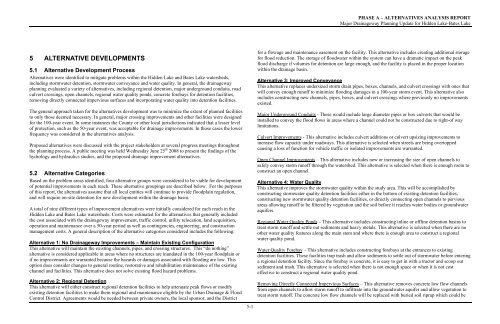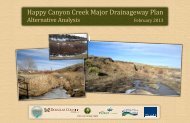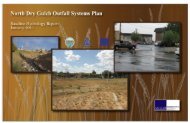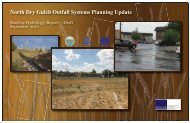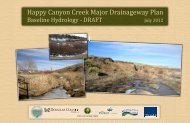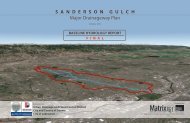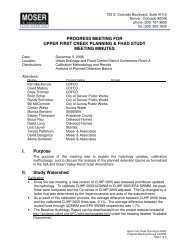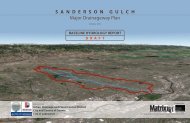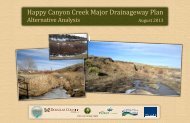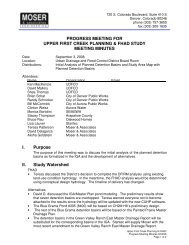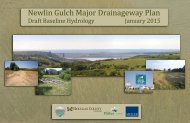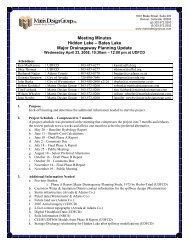Phase A - Alternatives Analysis Report - Urban Drainage and Flood ...
Phase A - Alternatives Analysis Report - Urban Drainage and Flood ...
Phase A - Alternatives Analysis Report - Urban Drainage and Flood ...
Create successful ePaper yourself
Turn your PDF publications into a flip-book with our unique Google optimized e-Paper software.
PHASE A – ALTERNATIVES ANALYSIS REPORTMajor <strong>Drainage</strong>way Planning Update for Hidden Lake-Bates Lake5 ALTERNATIVE DEVELOPMENTS5.1 Alternative Development Process<strong>Alternatives</strong> were identified to mitigate problems within the Hidden Lake <strong>and</strong> Bates Lake watersheds,including stormwater detention, stormwater conveyance <strong>and</strong> water quality. In general, the drainagewayplanning evaluated a variety of alternatives, including regional detention, major underground conduits, roadculvert crossings, open channels, regional water quality ponds, concrete forebays for detention facilities,removing directly connected impervious surfaces <strong>and</strong> incorporating water quality into detention facilities.The general approach taken for the alternatives development was to minimize the extent of planned facilitiesto only those deemed necessary. In general, major crossing improvements <strong>and</strong> other facilities were designedfor the 100-year event. In some instances the County or other local jurisdictions indicated that a lesser levelof protection, such as the 50-year event, was acceptable for drainage improvements. In those cases the lowerfrequency was considered in the alternatives analysis.Proposed alternatives were discussed with the project stakeholders at several progress meetings throughoutthe planning process. A public meeting was held Wednesday June 25 th 2008 to present the findings of thehydrology <strong>and</strong> hydraulics studies, <strong>and</strong> the proposed drainage improvement alternatives.5.2 Alternative CategoriesBased on the problem areas identified, four alternative groups were considered to be viable for developmentof potential improvements in each reach. These alternative groupings are described below. For the purposesof this report, the alternatives assume that all local entities will continue to provide floodplain regulation,<strong>and</strong> will require on-site detention for new development within the drainage basin.A total of nine different types of improvement alternatives were initially considered for each reach in theHidden Lake <strong>and</strong> Bates Lake watersheds. Costs were estimated for the alternatives that generally includedthe cost associated with the drainageway improvement, traffic control, utility relocation, l<strong>and</strong> acquisition,operation <strong>and</strong> maintenance over a 50-year period as well as contingencies, engineering, <strong>and</strong> constructionmanagement costs. A general description of the alternative categories considered includes the following:Alternative 1: No <strong>Drainage</strong>way Improvements – Maintain Existing ConfigurationThis alternative will maintain the existing channels, pipes, <strong>and</strong> crossing structures. This “do nothing”alternative is considered applicable in areas where no structures are inundated in the 100-year floodplain orif no improvements are warranted because the hazards or damages associated with flooding are low. Thisoption does consider changes to general routine, restorative <strong>and</strong> rehabilitation maintenance of the existingchannel <strong>and</strong> facilities. This alternative does not solve existing flood hazard problems.Alternative 2: Regional DetentionThis alternative will either construct regional detention facilities to help attenuate peak flows or modifyexisting detention facilities to make them regional <strong>and</strong> maintenance eligible by the <strong>Urban</strong> <strong>Drainage</strong> & <strong>Flood</strong>Control District. Agreements would be needed between private owners, the local sponsor, <strong>and</strong> the District5-1for a flowage <strong>and</strong> maintenance easement on the facility. This alternative includes creating additional storagefor flood reduction. The storage of floodwater within the system can have a dramatic impact on the peakflood discharge if volumes for detention are large enough, <strong>and</strong> the facility is placed in the proper locationwithin the drainage basin.Alternative 3: Improved ConveyanceThis alternative replaces undersized storm drain pipes, boxes, channels, <strong>and</strong> culvert crossings with ones thatwill convey enough runoff to minimize flooding damages in a 100-year storm event. This alternative alsoincludes constructing new channels, pipes, boxes, <strong>and</strong> culvert crossings where previously no improvementsexisted.Major Underground Conduits - These would include large diameter pipes or box culverts that would beinstalled to convey the flood flows in areas where a channel could not be constructed due to right-of waylimitations.Culvert Improvements - This alternative includes culvert additions or culvert upsizing improvements toincrease flow capacity under roadways. This alternative is selected when streets are being overtoppedcausing a loss of function for vehicle traffic or isolated improvements are warranted.Open Channel Improvements – This alternative includes new or increasing the size of open channels tosafely convey storm runoff through the watershed. This alternative is selected when there is enough room toconstruct an open channel.Alternative 4: Water QualityThis alternative improves the stormwater quality within the study area. This will be accomplished byconstructing stormwater quality detention facilities either in the bottom of existing detention facilities,constructing new stormwater quality detention facilities, or directly connecting open channels to perviousareas allowing runoff to be filtered by vegetation <strong>and</strong> the soil before it reaches water bodies or groundwateraquifers.Regional Water Quality Ponds – This alternative includes constructing inline or offline detention basins totreat storm runoff <strong>and</strong> settle out sediments <strong>and</strong> heavy metals. This alternative is selected when there are noother water quality features along the main stem <strong>and</strong> where there is enough area to construct a regionalwater quality pond.Water Quality Forebay – This alternative includes constructing forebays at the entrances to existingdetention facilities. These facilities trap trash <strong>and</strong> allow sediments to settle out of stormwater before enteringa regional detention facility. Since the forebay is concrete, it is easy to get in with a tractor <strong>and</strong> scoop outsediment <strong>and</strong> trash. This alternative is selected when there is not enough space or when it is not costeffective to construct a regional water quality pond.Removing Directly Connected Impervious Surfaces – This alternative removes concrete low flow channelsfrom open channels to allow storm runoff to infiltrate into the groundwater aquifer <strong>and</strong> allow vegetation totreat storm runoff. The concrete low flow channels will be replaced with buried soil riprap which could be


